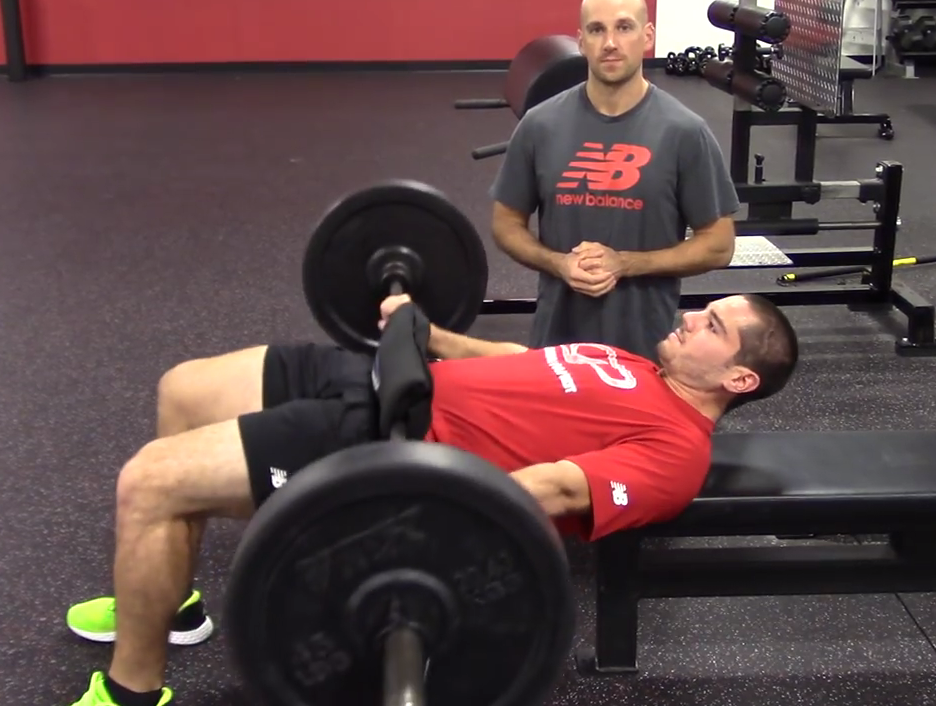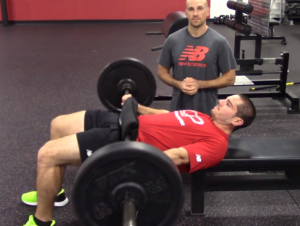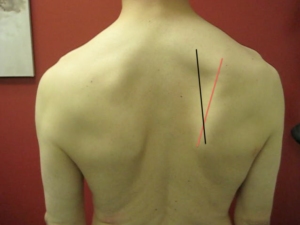
In Defense of the Hip Thrust
I’ve been a fan of barbell hip thrust and supine bridges for approximately seven years now. I’d encourage you to give my What I Learned in 2012 article a read, as it describes how our usage of these drills came about (and does so in an entertaining manner) following a meeting I had with Bret Contreras in 2009. Suffice it to say that initially, I was not a fan of these drills, but in-the-trenches experimentation eventually brought me around.
Recently, there has been some controversy over the utility of hip thrusts, as some newer research publications (here and here) have demonstrated that hip thrust training does not improve sprinting speed. Bret Contreras, the man who popularized the hip thrust, has written a detailed response to these publications. For the record, I think he’s handled the situation admirably, and I commend him for all his work adding to the body of knowledge so that we can all have these discussions in hopes of fine-tuning our strength training programs.
That said, not surprisingly, these research findings have created an opportunity for hip thrust critics to say “I told you so” – and several articles have emerged to highlight its lack of efficacy on this front. That said, I found Doug Kechijian’s article, ‘Science’ and the Barbell Hip Thrust, to be the best of the articles that have emerged. Doug doesn’t utilize the hip thrust, but used this current situation as a means of discussing how we view exercise selection on the whole. I’d strongly encourage you to give it a read.
While I must admit that I wasn’t particularly surprised at the lack of carryover to sprinting performance, I don’t think it’s time to throw the baby out with the bath water just yet. Why? As I’ve often said:
[bctt tweet=”Want to put an exercise in a program? You must be able to quickly and easily justify its inclusion.”]
In this case, I still have plenty of justifications for including hip thrusts and supine bridges in our programs. I don’t think they’re ever a perfect replacement for a squat or deadlift, but I do see a role for them in special circumstances, and as assistance exercises. In today’s post, I’ll outline why I still find these drills to have great utility.
1. Zero Back Pain
Yes, you read that right. In close to a decade of using these drills with clients, athletes, and our coaching staff, I’ve never seen anyone injured during a hip thrust or supine bridge. For how many other exercises can you say that? Certainly squats, deadlifts, kettlebell swings, or even single-leg work. In hindsight, it’s shocking that a drill that looks like it could be harmful (and this was my initial reluctance to include it) actually has such an excellent record on the safety front. Obviously, we’re matching it to the individual and coaching technique, but this is still an impressive observation.
Moreover, I’ve sold more than 8,000 copies of my flagship product, The High Performance Handbook. It includes barbell supine bridges in phase 2, and barbell hip thrusts in phase 3. This is 8,000+ people who’ve performed these exercises without my supervision, and I’ve never had a single email from anyone about an injury. Conversely, I’ve answered a ton of emails over the years from customers who need modifications because squatting and/or deadlifting aren’t drills they can perform pain-free. I think this is remarkably telling; hip thrusts have stood the test of time in terms of safety concerns.
Finally, I’ve actually seen quite a few individuals who couldn’t squat or deadlift pain-free actually perform barbell hip thrusts and supine bridges with zero pain over the course of years. They’ve bolstered a training effect that otherwise would have been markedly attenuated.
2. Hip thrusts allow us to train the posterior chain without deadlifts in a population that may not do well with scapular depression and downward rotation.
One thing we know about throwing a baseball is that it makes you very lat dominant and tends to drive scapular downward rotation.
As I discuss in this video, scapular upward rotation is incredibly important for throwers.
Sometimes, we’ll see athletes who sit in so much scapular depression or downward rotation that we choose to avoid lat dominant exercises and heavy carries/holds in their programs. So, drills like deadlifts, farmer’s walks, KB swings, and dumbbell lunges are out of the mix. When you lose deadlifts from a program, you realize that you’ve lost a big bang exercise for training the posterior chain. Barbell hip thrusts have been a huge help to us in this regard, as they give us a bilateral option for training the posterior chain. Otherwise, it’d be just safety squat bar (SSB) squats and single-leg work, the goblet set-up, belt squats, and glute-ham raise (GHR) variations. And, a lot of people don’t have a SSB, belt squat, or GHR!
Interestingly, I can actually think of several instances over the years where we dropped deadlifting from a pitcher’s program – and replaced it with hip thrusts – and his shoulder pain went away. I don’t think improvements like this happen in isolation, but I have no doubt that it contributed to the reduction in symptoms.
3. Hip thrusts prioritize terminal hip extension, which is actually far more important to baseball success.
I want you to watch these videos of the hips during the baseball swing (and while you’re at it, check out Jeff Albert’s great guest post for me: Hip Extension and Rotation in the Baseball Swing).
What I’m hoping you noticed is that while hip extension is incredibly important (for both the front and back legs), there is very little of it occurring in terms of actual range of motion. The same can be said of the pitching delivery; very rarely would a pitching come close to being a 90 degrees of hip flexion on the back hip.
Tim Collins early in his career was the most extreme hip flexion I’ve seen, and he’s not even all the way down to 90 degrees:
In other words, hips thrusts and supine bridges reflect the shorter range of hip flexion/extension motion we see in hitting and pitching than they do for a higher amplitude movement like sprinting.

Source: Darren Wilkinson
To be clear, I’m not saying that squats and deadlifts don’t train this range (especially when accommodating resistances like bands and chains are utilized); I’m just saying that hip thrusts and supine bridges train it exclusively and may provide some extra carryover.
4. Hip thrusts allow us to train the lower body without a grip challenge.
Load of gripping can also be an issue during the baseball season. Guys obviously get plenty of it from their upper body work, but when you add in the stress of throwing on the flexor tendons, more work on lower body days can push some pitchers over the edge in terms of forearm symptoms. This can also be an issue during post-operative elbow scenarios, as some surgeons can “beat up” the flexor tendon a bit more during Tommy John surgeries. With these athletes, we’ll often plug hip thrusts in to replace deadlifts for 4-8 week spans.
5. Hip thrusts help to maintain a training effect in post-operative elbow and shoulder situations.
Building on my last point, we utilize barbell hip thrusts and supine bridges a lot with our post-op clients. If we are talking about a Tommy John surgery, you aren’t using a safety squat bar until two months post-op, or deadlifting until closer to five months (and even then, the loading has to be severely restricted). Conversely, provided they have someone to load plates for them, these athletes can hip thrust as early as 4-6 weeks (assuming we aren’t dealing with a lower extremity graft site), and loading appreciably by weeks 8-10. That’s a huge deal.
Shoulder surgeries are a bit slower to come around, but you’re definitely able to hip thrust well before you use the safety squat bar or integrate deadlifts. In short, if you want bilateral loading in a post-operative situation, hip thrusts below right up there in the discussion with glute-ham raises – and serve as a good complement to sled dragging with a belt/harness and various single-leg drills.
6. Hip thrusts don’t create much delayed onset muscle soreness.
It’s hard to really overload the eccentric (lowering) component of a hip thrust – and this may be one reason why it doesn’t carry over to sprinting as much as a squat would. However, this non-soreness-inducing quality can actually be of benefit, as we often want to avoid it with in-season athletes or those trying to achieve a higher volume of work in their training programs. This is actually a perk of several deadlift variations, too.
7. Hip thrusts are a safe way to get in higher-rep sets.
In the quest to put on some muscle, high-rep squatting and deadlifting often wind up getting pretty ugly by the end of the sets unless they’re regressed in some fashion (e.g., goblet squats). And, on a personal note, any time that I deadlift for more than eight reps, I get a massive headache that lasts about three days. I’ve found that higher rep barbell supine bridge (moreso than hip thrusts) are a good option for sets of 12-15 at the end of a session to kick in some extra volume safely. It’s pretty darn hard to screw this up, you know?
Thoughts on Loading
On several occasions, I’ve heard folks criticize barbell hip thrusts and supine bridges because even seemingly untrained individuals can use so much weight. It’s a valid assertion – but only to a point.
My experience has been that many individuals moving big weights are really short-changing themselves on the last 5-10 degrees of hip extension. They’re either stopping short or getting lumbar extension (moving through the lower back). Often, when you fine-tune the technique and make them hold for a count at the top, they’ll have to reduce the weight significantly. As a rule of thumb, though, I view the risk:benefit ratio with hip thrusts as being comparable to that of deadlifts in an athletic population; going heavier than 495 pounds probably isn’t worth the risk or time involved. You’re better off changing the tempo (longer pauses at the top) or switching to a different (and possibly more technically advanced) exercise that doesn’t “come naturally” to the lifter. In short, find a different window of adaptation instead of just trying to move big weights through a short range-of-motion.
As an interesting aside to this, my deadlifts are actually significantly stronger than my hip thrusts. It’s likely a function of “getting what you train,” but I think it’s an interesting argument against the idea that even weak people can automatically move big weights.
Last, but not least, remember that relatively untrained people can often push a lot of weight on sleds on turf, and rack pulls are usually substantially heavier than one’s deadlift. Does that make them useless, too?
Closing Thoughts
New research is always warranted in any field, but particularly in strength and conditioning, a dynamic industry that has changed remarkably over the past few decades. In many cases, it takes a lot of time and experimentation to understand just how something fits (or doesn’t fit) in our training approaches. Personally, I always come back to the “justifying the inclusion of a lift” question I noted earlier in this article. My experience has been that barbell hip thrusts and supine bridges have stood the test of time in this regard – and done so safely. I view them much more as an assistance exercise, as opposed to something that would ever replace squats or deadlifts. However, in the special circumstances I’ve outlined above, I think they will continue to fill in nicely.





